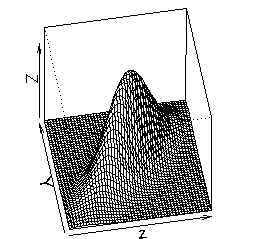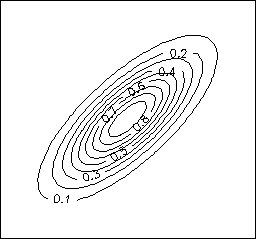In particular, we will look for outliers. For univariate data, outliers are easy to spot by sorting the residuals. For multivariate data, the residuals are also multivariate, so how do we define "most unusual"? One idea is to use the multivariate length of the residual: ||x - xhat||. This doesn't quite work because it doesn't consider that different variables might have different amounts of spread, and that they might be correlated.



The multivariate normal distribution can be used to define outliers, just as with the univariate normal. In both cases, an outlier is a value whose probability is unexpectedly small. In the univariate case, this is a point far from the mean, in either direction. In the multivariate case, this is a point far from the mean, where some directions count more than others. Directions with large spread require the point to be farther away before it is considered an outlier.
The procedure is thus: fit a multivariate normal distribution to the dataset, compute the probability of each point, and flag the points whose probability is unexpectedly low (using p-values). The function outliers does this.
> x[1,]
Price MPG.highway EngineSize Horsepower Passengers
Acura Integra 15.9 31 1.8 140 5
Length Wheelbase Width Turn.circle Weight
Acura Integra 177 102 68 37 2705
> i <- outliers(x)
D2 p.value
Chevrolet Corvette 38.21730 3.478412e-05
Mercedes-Benz 300E 34.44389 1.552920e-04
Dodge Stealth 33.78617 2.007485e-04
Mazda RX-7 32.53516 3.259493e-04
Ford Aerostar 30.49141 7.115836e-04
Geo Metro 23.73304 8.341393e-03
Chevrolet Astro 21.18824 1.981855e-02
Mercury Cougar 19.54928 3.381575e-02
Honda Civic 19.36320 3.588471e-02
Volkswagen Eurovan 18.64282 4.504106e-02
These cars all have p-values less than 5%, meaning that their probabilities
are so low that we would expect a multivariate normal dataset of this size
to have such cars less than 5% of the time.
For each outlier car, we would like to know what makes it different from the rest of the data: is it an unusual size, unusual price, etc.? In general, if you want to know what makes two groups different, you can think of the groups as classes and use classification methods to distinguish them. Let's use discriminative projection:
i <- outliers(x)[1] x$cluster <- rep(F,nrow(x)) x[i,"cluster"] <- T x$cluster <- factor.logical(x$cluster) sx <- scale(x) w <- projection(sx,2,type="m") cplot(project(sx,w),axes=F) plot.axes(w)

We can avoid typing the above sequence of commands by using the convenience function separate. Let's look at the second outlier car:
> i <- outliers(x)[2]
> separate(x,i)
Price Width Passengers MPG.highway Wheelbase
-0.84792449 -0.24664714 -0.12396093 -0.05775463 -0.02421979
Turn.circle EngineSize Length Weight Horsepower
0.06843721 0.07269870 0.16373487 0.27272652 0.29957158

Finally, the third outlier car:
> i <- outliers(x)[3]
> separate(x,i)
Wheelbase EngineSize Price Turn.circle Width
-0.489502780 -0.275354612 -0.195988691 -0.026335603 0.002412840
Length Passengers MPG.highway Horsepower Weight
0.015204207 0.124316064 0.194260598 0.418239977 0.645839301
The Dodge Stealth is unusual because it has the Price, EngineSize, and
Wheelbase of a coupe but the Horsepower and Weight of a sports car.
sx <- scale(x)
hc <- hclust(dist(sx)^2,method="ward")
cluster <- factor(cutree(hc,k=4))
y <- x[cluster==1,]
> y
Income Illiteracy Life.Exp Homocide HS.Grad Frost
Alabama 3624 2.1 69.05 15.1 41.3 20
Arkansas 3378 1.9 70.66 10.1 39.9 65
Georgia 4091 2.0 68.54 13.9 40.6 60
Kentucky 3712 1.6 70.10 10.6 38.5 95
Louisiana 3545 2.8 68.76 13.2 42.2 12
Mississippi 3098 2.4 68.09 12.5 41.0 50
New Mexico 3601 2.2 70.32 9.7 55.2 120
North Carolina 3875 1.8 69.21 11.1 38.5 80
South Carolina 3635 2.3 67.96 11.6 37.8 65
Tennessee 3821 1.7 70.11 11.0 41.8 70
Texas 4188 2.2 70.90 12.2 47.4 35
West Virginia 3617 1.4 69.48 6.7 41.6 100
Are there any unusual states here? outliers suggests two:
> outliers(y,0.2)
D2 p.value
New Mexico 9.645276 0.1404071
West Virginia 9.399917 0.1523046
Since there are only a few variables in this dataset, we can examine
the outliers using a parallel-coordinate plot:
> parallel.plot(y) axis reversed for Illiteracy Homocide columns are -Illiteracy -Homocide Frost Life.Exp HS.Grad Income
